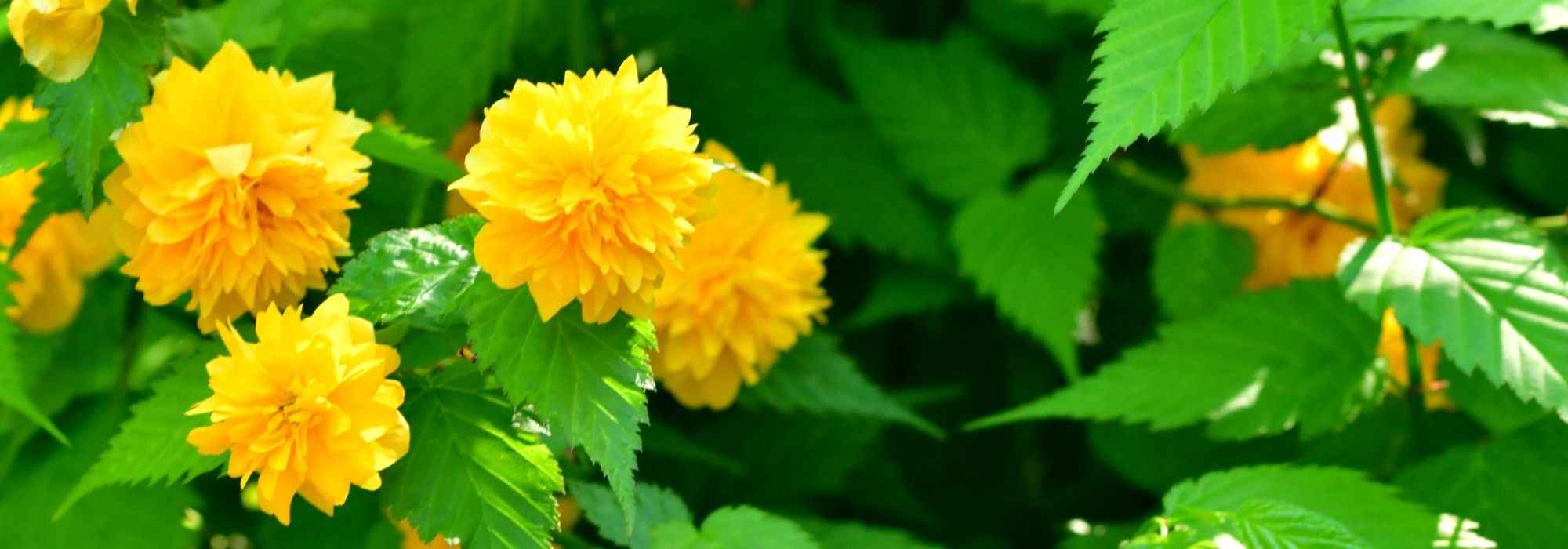
Associate the Japanese quince
Inspiration for pairing your yellow flowers
Contents
The Japanese rose is an iconic spring bush. Although it may be a bit out of fashion today, this bush has many advantages: generous flowering, easy cultivation in all soils, very good hardiness, rapid growth, and low susceptibility to diseases. What more could you ask for?! The Kerria japonica ‘Pleniflora’ is the most well-known with its cute orange-yellow pompom flowers, but there are other interesting cultivars, such as those with variegated foliage or single flowers. This yellow flowering, effective for brightening up the beautiful days in spring, can be showcased in various ways: as a hedge, in a border, or in a pot on a terrace. Discover my ideas for combinations to accompany this charming bush!
⇒ Discover everything you need to know about the Japanese rose, Kerria japonica: planting, pruning, maintaining in our advice sheet.
In a spring border bursting with colour
In spring scenes, Japanese roses pair beautifully with spring bulbs or early flowering plants. With its lovely yellow flowering and upright, slightly arching habit, the Japanese rose is an excellent decorative element. For example, to border a terrace, you can easily combine it with bulbous plants at its base. To avoid obstructing the view, plant it as a specimen. Then play with bulbs of different shapes, sizes, and colours to add originality. Be careful, its location should be sheltered from strong winds that can damage its flexible branches.
The Kerria japonica ‘Picta’ adds a touch of brightness with its green foliage variegated with cream. Its lemon-yellow flowers pair well with pink, mauve, and blue tones. Create a carpet of flowers with blue hyacinth ‘General Kohler’, whose double flowers are pleasantly fragrant; the pink, conical flowers of Muscari ‘Pink Sunrise’; and the single tulip ‘Bleu Aimable’, which adds volume and energises the border with its intense mauve colour. The Narcissus triandrus ‘Hawera’ echoes the yellow of the Japanese rose. The biennial Myosotis sylvatica ‘Roi des Carmins’ provides a light finish with its tiny, numerous pink flowers.

Kerria japonica ‘Picta’ (photo Globetrotter19 – Wikimedia), Hyacinth ‘General Kohler’, Tulip ‘Bleu Aimable’ and Muscari ‘Pink Sunrise’
In a free-standing hedge
The Japanese rose is a remarkable hedge bush. Let it adopt a free habit. Indeed, this bush does not require formative pruning. Only a simple thinning and removal of suckers are carried out once a year after flowering. This is to respect the plant’s physiognomy. Kerria displays a bushy and sparsely branched silhouette. When in flower from April to May, its curved branches resemble a golden fountain. To create your natural-style hedge, choose medium-sized bushes (1 to 2 m high), with deciduous or evergreen foliage. If possible, prefer nectariferous plants to provide nectar and pollen for garden insects.
To ensure a decorative effect all year round, select bushes that flower in different seasons. In spring, the single and solitary flowers of the Japanese rose ‘Golden Guinea’ combine with the tangy foliage and white flowering of the Mexican orange blossom ‘Aztec Gold’, as well as the pale pink flowers of the evergreen Cotoneaster lucidus. Then, the large-flowered abelia and the Vitex agnus-castus ‘Pink Pinnacle’ take over the flowering in summer, followed by the nectariferous Caryopteris clandonensis ‘Good as Gold’. For autumn and winter, focus on the winter honeysuckle, the hardy and rare Mahonia confusa ‘Nara Hiri’, the deciduous Japanese quince, as well as the melliferous Korean pink forsythia (Abeliophyllum distichum ‘Roseum’). Very hardy, the Japanese rose can also be included in this hedge and offer repeat flowering (for example, the Rosa rugosa ‘Roseraie de l’Haÿ’ with its magnificent double fuchsia-tinged roses).
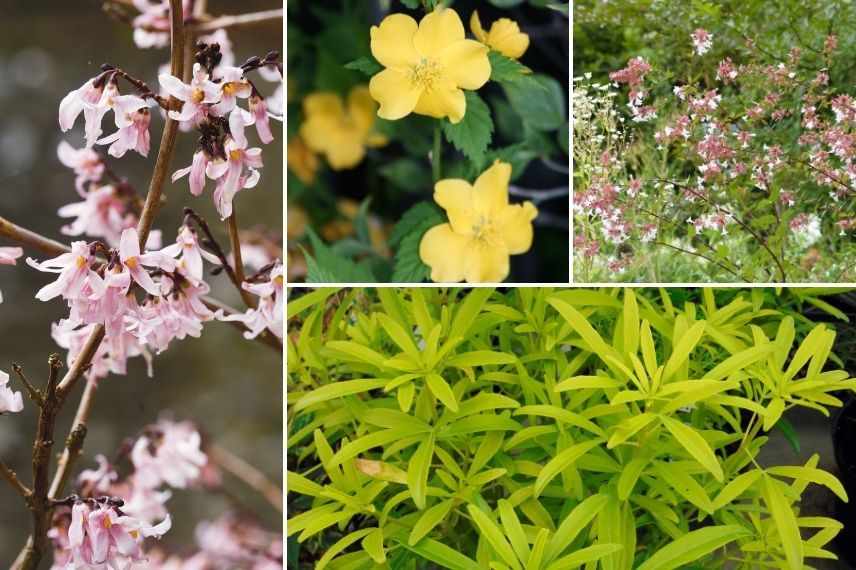
Abeliophyllum distichum ‘Roseum’ (copyright MAP GWI Trevor Sims), Kerria japonica ‘Golden Guinea’, Abelia grandiflora and Choisya ternata ‘Aztec Gold’
Discover other Kerrias
View all →Available in 0 sizes
Available in 1 sizes
Available in 2 sizes
Available in 1 sizes
Available in 1 sizes
In the background of a perennial bed
The Japanese rose can serve as a backdrop in a border formed of flowering perennials and decorative foliage. Opt for the famous Kerria japonica ‘Pleniflora’ that offers double pompom flowers in orange-yellow. To highlight its generous sunny flowering, pair it with other ornamental bushes. The Spiraea arguta dresses its flexible, trailing branches with countless white flowers from April to May. A spectacular bloom! Also, install a flowering currant. Less known and with a more original flowering than the classic Ribes sanguineum, the Gordon’s currant displays multicoloured cluster inflorescences: red, cream, and peach!
At their feet, create a lush spring display. The pink hearts of the Dicentra spectabilis mingle with the large buttercups of the Mountain Troll. Very robust, the deep purple of the Mountain cornflower ‘Amethyst Dream’ pairs well with pink or yellow flowers. Not exceeding 20 cm in height, the Alpine aster pink is ideal at the front of the border where it spreads like a cushion. The silver basket ‘Plena’ is also an excellent groundcover for borders or walls. In spring, it is covered with double, fragrant white flowers! To complete the combination, add the Carex comans ‘Milk Chocolate’ with its airy bronze, brown, and pink mane in spring, as well as the sage ‘Aurea’ forming a dense tuft of evergreen leaves, green edged with pale yellow.

Kerria japonica ‘Pleniflora’, Spiraea arguta (photo Wikipedia), Ribes gordonianum, Dicentra spectabilis, Centaurea montana ‘Amethyst Dream’, Salvia officinalis ‘Aurea’ and Trollius europaeus
With decorative wood trees and bushes
Deciduous, the Japanese rose loses its foliage in autumn and remains naked during winter. However, its bright green branches all year round give it a lovely appearance during the late season. To brighten up the winter period, nothing is better than planting the kerria alongside trees or bushes with decorative bark.
Pair the green branches of your Japanese rose with the golden wood of the Cornus stolonifera ‘Flaviramea’ and the orange wood of the golden willow Salix alba ‘Vitellina’. The culms of bamboo are also very aesthetic. For example, the Phyllostachys nigra produces remarkable black canes! Among trees, the very white bark of the Himalayan birch brightens up this scene. Another interesting subject for its coloured wood is the Acer palmatum ‘Sango-Kaku’. Its coral-red branches attract the eye in winter. For an original touch, consider the twisted hazel ‘Contorta’ which features twisted branches!

Acer palmatum ‘Sango-Kaku’ (photo F.D. Richards – Flickr), Kerria japonica (photo Plant Image Library -Wikimedia), Salix alba ‘Vitellina’, Phyllostachys nigra (photo Shawn Henning), Corylus avellana ‘Contorta’ (photo iagoarchangel) and Betula utilis var. jacquemontii
In a scene composed of potted bushes
Container cultivation of the Japanese rose is possible provided you use a sufficiently large container to ensure its proper development. Additionally, regular watering throughout the growing season is essential. Plant your Kerria japonica alone in a large tub that you will place in a sunny or partially shaded position in the hottest regions.
For example, choose Kerria japonica ‘Picta’, which is very attractive with its variegated foliage. Next to it, arrange other bushes, each in their pot. The evergreen and variegated euonymus are very decorative and perfectly suited for container planting (Euonymus fortunei ‘Dan’s Delight’, for example). Spireas are renowned for their beautiful summer flowering and autumn colouring. Choose the Spiraea japonica ‘Double Play Big Bang Tracy’, which has remarkable foliage that changes colour throughout the seasons. Weigela can also be used in pots. If you have limited space, the dwarf variety Weigela florida ‘Picobella Rosa’ is perfect for you. At maturity, this bush reaches 40 cm in height with a diameter of 60 cm. You can also opt for a dwarf butterfly tree. The Buddleia davidii ‘Sophie’ blooms profusely in purple clusters from April to September! Also consider shrubs with decorative foliage such as photinias or physocarpus with alder-like leaves (Photinia fraseri ‘Chico’ with copper-red leaves and Physocarpus opulifolius ‘Little Joker’ with orange-purple leaves).

Euonymus fortunei ‘Dan’s Delight’, Physocarpus opulifolius ‘Little Joker’, Spiraea ‘Double Play Big Bang Tracy’ and Kerria japonica ‘Picta’ (photo Salicyna-Wikimedia)
- Subscribe!
- Contents
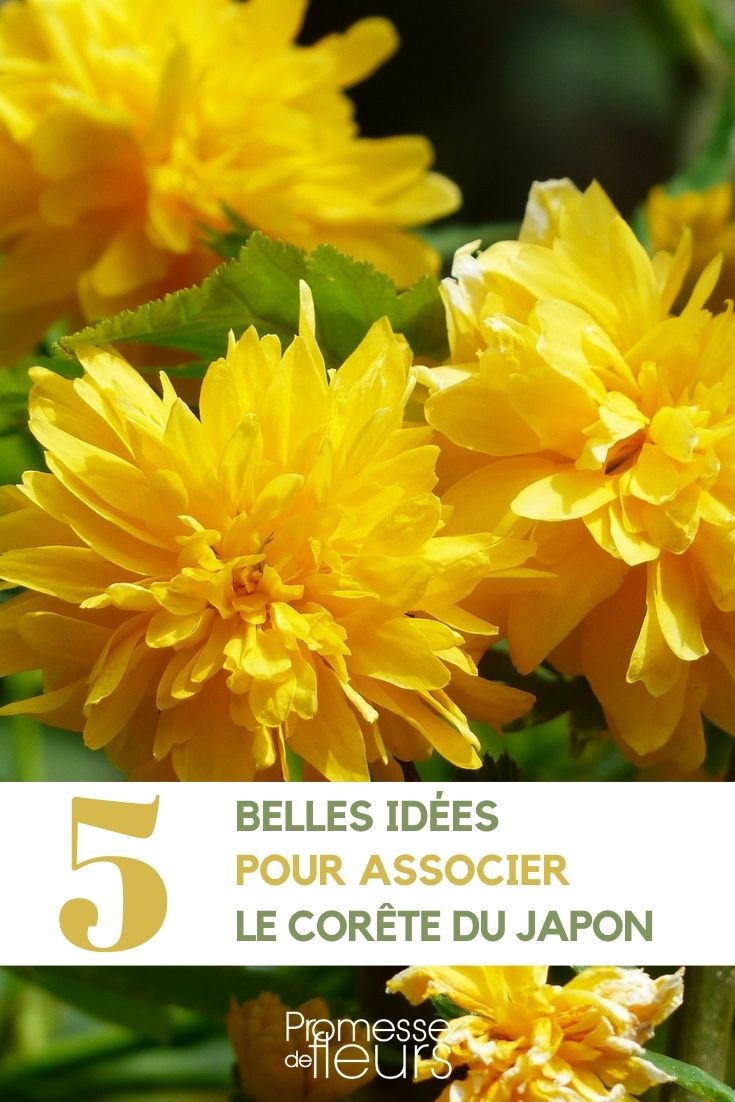































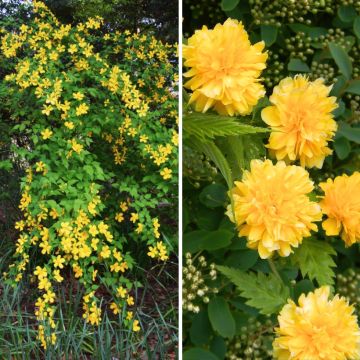
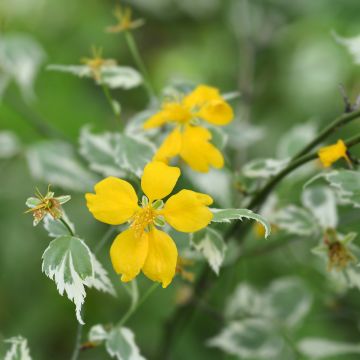
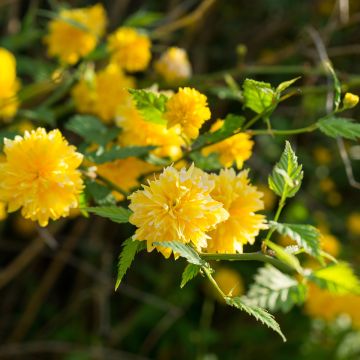
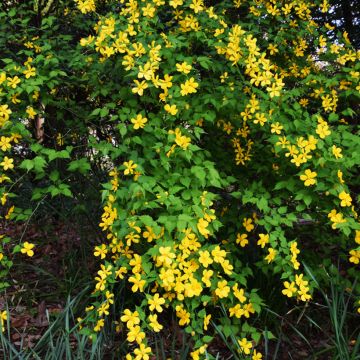

Comments